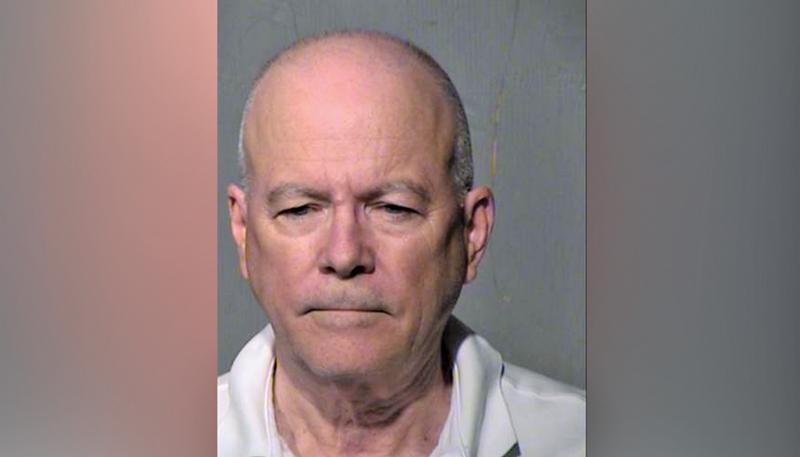“‘Father Tim is gone,'” he recalls being told. “It was kind of shocking … People were distressed. He was there in the morning, he was gone in the afternoon. We didn’t know what to think.”
Later that summer of 1993, bishop Kenneth Povish appeared at Mass at St. Thomas along with the attorney for the Diocese of Lansing. The prelate told parishioners that Crowley had been sent away for “grievous” sexual misconduct. “He tried to put people’s minds at rest,” says Hecht. “He did not go into specifics.”
The specifics would have been even more shocking. The diocese had paid $200,000 to a young man who signed a nondisclosure agreement and filed an affidavit saying Crowley molested him at St. Thomas and at two other parishes, starting when he was a ten-year-old altar boy and continuing for eight years.
Now Crowley, at age seventy, is coming back to Washtenaw County for the first time since he suddenly vanished twenty-six years ago. He’ll arrive in a prisoner transport van to face eight counts of criminal sexual conduct. If convicted, he could spend the rest of his life in prison.
It’s happening now because new state attorney general Dana Nessel is aggressively pursuing abuse cases involving Catholic priests. The A.G.’s office raided all seven Michigan dioceses last fall and seized tens of thousands of documents relating to past abuse and opened a tip line to take new reports. Crowley was one of five former Michigan priests swept up in a nationwide dragnet on May 23.
Crowley was arrested at his home in Tempe, AZ. “This is the tip of the iceberg,” Nessel said in a press conference, adding that she is “pursuing any and all individuals who abuse their power.”
The Lansing diocese says that it released the young man from the confidentiality agreement in 2002 and turned its file on Crowley over to the Washtenaw County prosecutor’s office at that time.
Prosecutor Brian Mackie, who knows the case well, confirmed he wanted to arrest Crowley years ago but says that the victim didn’t want to press charges and “had a very compelling argument” why he didn’t want a trial.
Attorney General spokesperson Dan Olsen says “we wouldn’t bring charges without the consent and cooperation of the victim.” So did the victim change his mind, or is there another victim? Olsen says he can’t answer that question, but the AG’s complaint alleges eight instances of criminal sexual conduct with a teenager between June 1986 and the end of 1990–which fits the timeline in the original 1993 affidavit.
“Long overdue” was the reaction from David Clohessy of SNAP (Survivors Network of those Abused by Priests), the leading church abuse victims organization, to the news of Crowley’s arrest. In an all-too-typical pattern, Crowley continued to work as a priest until 2002 and was not defrocked until 2015.
When Crowley “resigned” his post at St. Thomas in 1993, he was sent to a church-approved treatment center in Alma, pronounced “cured” after a year there, and shipped off to Alaska–where he was not only permitted to say Mass but served as spokesman for the Anchorage archdiocese.
O’Brien writes that Lansing warned Anchorage of Crowley’s transgressions. But archbishop Roger Schwietz, who took over in 2001, said he’d been told the abuse lasted only about three years, not eight, and that he’d never seen the victim’s affidavit. “There’s never been any hint of his doing anything wrong with anybody” in Alaska, Schwietz told the Anchorage Daily News in 2003. But the paper published appalling details from the affidavit–that the boy had stayed overnight with Crowley in rectories where the priest showed him porn, gave him beer and whiskey, and assaulted him, even holding him down so another man, a youth minister, could molest him on his birthday.
According to the affidavit, the abuse began in an unspecified parish “west of Detroit” and then continued at St. Anthony in Hillsdale and then at St. Thomas. The victim also claimed he was molested at Crowley’s home in Michigan Center. The new charges, however, focus only on acts at St. Thomas.
If Crowley had remained in Michigan, those acts would now be outside the statute of limitations. But when the church shipped him out of state, it also paused that clock, which means he can still be prosecuted.
In the wake of Crowley’s departure, Fr. William Ashbaugh was assigned to St. Thomas in 1994–he’s since left and returned as pastor there. When he first arrived, he says in an email, “I was told that the priest–Fr. Crowley was removed because of sexual abuse–and that it was my understanding that some of it occurred in the rectory.” As a result, he says, “There were changes made at the time in taking steps to protect minors. No minor was ever allowed in the rectory unaccompanied by a parent … Windows were placed in doors for more openness and accountability.”
Before his death in 2003, Bishop Povish admitted to the Ann Arbor News that Crowley had abused a minor but minimized it as a “one-time thing that involved one boy.” No church official ever came back to St. Thomas to tell parishioners the full story.
“Sexual abuse by clergy was not widely spoken about among people back then like it is today,” Fr. Ashbaugh says. “There was a sense in the parish of healing and moving on.” And Ashbaugh emphasizes that the church has since put many protocols in place to prevent future abuse. But Nessel and other state attorneys general have reopened the books on a long and painful history.
A preliminary hearing on the charges against Crowley will be scheduled once he returns to Michigan. He’s expected to arrive sometime early this month.
